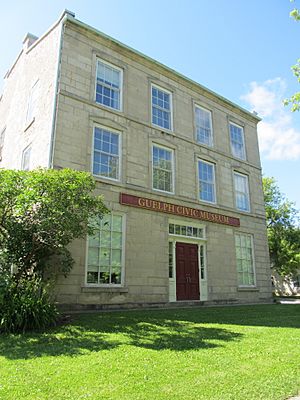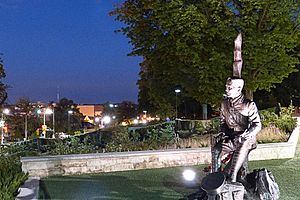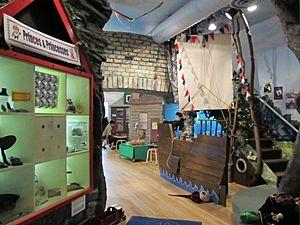Guelph Civic Museum facts for kids
 |
|
| Established | 1967 |
|---|---|
| Location | 52 Norfolk Street, Guelph, Ontario, N1H 4H8 |
| Visitors | 33,000+ (2010) |
| Public transit access | Norfolk at Albion. Stop ID: 1101 |
The Guelph Civic Museum is a cool place in Guelph, Ontario. It's a museum that teaches you all about the culture and natural history of the area. The museum shows off Guelph's past through fun exhibits and special events. It's located at 52 Norfolk Street, in a beautifully renovated building called the Loretto Convent. This building sits on a hill right next to the famous Church of Our Lady. The museum has over 30,000 amazing items. Many of these items were given by people who live in Guelph. The museum moved to its current spot in January 2012. Before that, it was in a different building on Dublin Street South.
Contents
Discovering the Guelph Civic Museum
The Guelph Civic Museum is a popular spot in Guelph. It tells the story of Guelph from its very beginning up to today. You can learn so much through its many exhibits and interactive displays. The museum also offers special events and educational programs. It has permanent exhibits that are always there, plus changing exhibits that are new all the time. There's also a special room for programs and a meeting room. Behind the scenes, the museum stores its huge collection of artifacts.
What You Can See at the Museum
The Guelph Civic Museum has about 40,000 artifacts! These include lots of old photographs and important historical items. You can see furniture, old clothes, toys, and folk art. The museum also displays objects related to human history. There are also beautiful decorative arts like pottery and tapestries. The museum has several different galleries. These include the Royal City Families Gallery and galleries about Guelph's local history. There are also two spaces for temporary exhibits that change often.
How to Visit the Museum
Here are the admission fees to visit the Guelph Civic Museum:
- General admission: $5.00
- Families (2 adults & up to 4 children maximum): $15.00
- Children under 4 years old: Free
Your ticket to the Guelph Civic Museum also lets you visit McCrae House.
The Museum's Journey Through Time
The idea for a museum in Guelph started in 1964. A group called the Museum Board of Management suggested creating a "memory bank" for important events. Guelph's Historical Society had already started collecting items two years earlier. The museum had temporary exhibits in different places before it officially opened. In December 1967, it opened at the Winter Fair Horse Stables. This building is now the Guelph Farmer's Market.
In 1965, a sewing exhibit was shown at the Delhi Street Recreation Centre. Other exhibits were displayed at the Guelph Public Library in 1967. That same year, a "summer museum" was set up at 98 Wyndam Street. From 1967, the museum stayed in the old stables. But by the 1970s, it needed more space.
A New Home on Dublin Street
The building at 6 Dublin Street was bought in 1977. On May 18, 1980, which was International Museum Day, it opened as the new Guelph Civic Museum. This building was the museum's home for over thirty years. It was designed by William Thomas and built in 1847. The building is made of limestone and is about 11,000 square feet (1,000 m2) in size. It was first owned by the Robert Day family. Over the years, it was many different things. It was a tavern, a hotel, and even a boarding house for the Ontario Agricultural College. It was also used by the Great War Veterans Association and the Canadian Legion. Finally, it was sold to the city in 1977.
Moving to the Loretto Convent
The museum needed even more space again. So, in the summer of 2011, it moved to a bigger location. This new home is the Loretto Convent. It is located right next to the Basilica of Our Lady Immaculate downtown. Renovations were completed by the fall of September 2011. The museum closed to the public on June 30, 2011, to get ready for the move. It then reopened at 52 Norfolk Street in January 2012.
Remembering John McCrae
In 2015, a special statue was placed in front of the Guelph Civic Museum. It's a sculpture of Lieutenant Colonel John McCrae by Ruth Abernethy. John McCrae was a famous Canadian. He wrote the well-known poem In Flanders Fields during World War I. The statue shows him as an army officer, writing, with his medical bag nearby. It also shows the destruction of a battlefield. At his feet, you can see poppies. These flowers are a symbol to remember World War I and all other wars.
McCrae House is also part of the Guelph Museums. It's located at 108 Water Street. This is the house where John McCrae was born. His house was saved to remember him and his life.
Fun for Families: The Children's Museum
The Children's Museum used to be on the first floor of the old Civic Museum building on Dublin Street. It was called the Rogers Yahoo! Hi-Speed Internet Growing Up in Guelph Children's Museum. It was designed to be a fun, interactive place for kids. Children could play and learn about Guelph's history. The exhibits and events often followed monthly themes.
In the Guelph Civic Museum's new home at the Loretto Convent, the Children's Museum is now called the Royal City Families Gallery. It has twice as much space as it did before!
Who Helps Run the Museum?
The museum has a great team of people who help run it. As of 2019, some of the staff included:
- Tammy Adkin – Manager
- Dawn Owen - Curator (This person helps take care of the museum's collections)
- Val Harrison – Supervisor, Visitor Experiences (This person makes sure visitors have a great time)
- Luke Stempien – Collections Coordinator (This person helps organize the museum's items)
- Ken Irvine - Education Coordinator (This person plans learning programs)
- Judi Prigione – Administration Coordinator (This person helps with office tasks)
- Alex Jacobs-Blum - Indigenous Community Relations Coordinator (This person works with Indigenous communities)
- Linda Fazzari - Bookings & Facility Rental Coordinator (This person helps people book events at the museum)




